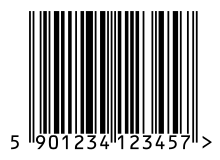
The International Article Number (also known as European Article Number or EAN) is a standard describing a barcode symbology and numbering system used in global trade to identify a specific retail product type, in a specific packaging configuration, from a specific manufacturer. The standard has been subsumed in the Global Trade Item Number standard from the GS1 organization; the same numbers can be referred to as GTINs and can be encoded in other barcode symbologies, defined by GS1. EAN barcodes are used worldwide for lookup at retail point of sale, but can also be used as numbers for other purposes such as wholesale ordering or accounting. These barcodes only represent the digits 0–9, unlike some other barcode symbologies which can represent additional characters.
The most commonly used EAN standard is the thirteen-digit EAN-13, a superset of the original 12-digit Universal Product Code (UPC-A) standard developed in 1970 by George J. Laurer.[1] An EAN-13 number includes a 3-digit GS1 prefix (indicating country of registration or special type of product). A prefix with a first digit of "0" indicates a 12-digit UPC-A code follows. A prefix with first two digits of "45" or "49" indicates a Japanese Article Number (JAN) follows.
The less commonly used 8-digit EAN-8 barcode was introduced for use on small packages, where EAN-13 would be too large. 2-digit EAN-2 and 5-digit EAN-5 are supplemental barcodes, placed on the right-hand side of EAN-13 or UPC. These are generally used in periodicals, like magazines[2] and books,[3] to indicate the current year's issue number and in weighed products like food, to indicate the manufacturer's suggested retail price.
- ^ "Alumni Hall of Fame Members". University of Maryland Alumni Association. The University of Maryland. 2005. Archived from the original on 2007-06-23. Retrieved 2009-06-10.
After graduating from Maryland in 1951, George Laurer joined IBM as a junior engineer and worked up the ranks to senior engineer. In 1969, he returned to the technical side of engineering and was later assigned the monumental task of designing a code and symbol for product identification for the Uniform Grocery Product Code Council. His solution – the Universal Product Code – radically changed the retail world. Since then, he has enhanced the code by adding a 13th digit. Laurer retired from IBM in 1987. He holds some 25 patents and is a member of the university's A. James Clark School of Engineering Hall of Fame.
- ^ "Barcodes for Magazines".
- ^ "Barcodes for Books". Archived from the original on 2013-01-02. Retrieved 2012-12-20.